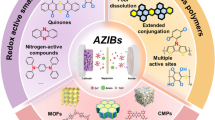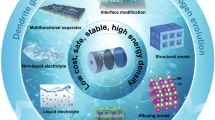Abstract
Electrochemical lithium extraction from salt lakes is an effective strategy for obtaining lithium at a low cost. Nevertheless, the elevated Mg : Li ratio and the presence of numerous coexisting ions in salt lake brines give rise to challenges, such as prolonged lithium extraction periods, diminished lithium extraction efficiency, and considerable environmental pollution. In this work, LiFePO4 (LFP) served as the electrode material for electrochemical lithium extraction. The conductive network in the LFP electrode was optimized by adjusting the type of conductive agent. This approach resulted in high lithium extraction efficiency and extended cycle life. When the single conductive agent of acetylene black (AB) or multiwalled carbon nanotubes (MWCNTs) was replaced with the mixed conductive agent of AB/MWCNTs, the average diffusion coefficient of Li+ in the electrode increased from 2.35 × 10−9 or 1.77 × 10−9 to 4.21 × 10−9 cm2·s−1. At the current density of 20 mA·g−1, the average lithium extraction capacity per gram of LFP electrode increased from 30.36 mg with the single conductive agent (AB) to 35.62 mg with the mixed conductive agent (AB/MWCNTs). When the mixed conductive agent was used, the capacity retention of the electrode after 30 cycles reached 82.9%, which was considerably higher than the capacity retention of 65.8% obtained when the single AB was utilized. Meanwhile, the electrode with mixed conductive agent of AB/MWCNTs provided good cycling performance. When the conductive agent content decreased or the loading capacity increased, the electrode containing the mixed conductive agent continued to show excellent electrochemical performance. Furthermore, a self-designed, highly efficient, continuous lithium extraction device was constructed. The electrode utilizing the AB/MWCNT mixed conductive agent maintained excellent adsorption capacity and cycling performance in this device. This work provides a new perspective for the electrochemical extraction of lithium using LFP electrodes.
Similar content being viewed by others
References
Q.X. Wu, Z.F. Pan, and L. An, Recent advances in alkali-doped polybenzimidazole membranes for fuel cell applications, Renewable Sustainable Energy Rev., 89(2018), p. 168.
Y.B. Liu, B.Z. Ma, Y.W. Lü, C.Y. Wang, and Y.Q. Chen, A review of lithium extraction from natural resources, Int. J. Miner. Metall. Mater., 30(2023), No. 2, p. 209.
X.D. Wang, R.B. Yu, C. Zhan, W. Wang, and X. Liu, Editorial for special issue on advanced energy storage and materials for the 70th Anniversary of USTB, Int. J. Miner. Metall. Mater., 29(2022), No. 5, p. 905.
N. Li, S. Q. Yang, H. S. Chen, S.Q. Jiao, and W.L. Song, Mechano-electrochemical perspectives on flexible lithium-ion batteries, Int. J. Miner. Metall. Mater., 29(2022), No. 5, p. 1019.
J.H. Li, Y.F. Cai, H.M. Wu, et al., Polymers in lithium-ion and lithium metal batteries, Adv. Energy Mater., 11(2021), No. 15, art. No. 2003239.
M.A. Hannan, M.S.H. Lipu, A. Hussain, and A. Mohamed, A review of lithium-ion battery state of charge estimation and management system in electric vehicle applications: Challenges and recommendations, Renewable Sustainable Energy Rev., 78(2017), p. 834.
J.B. Dunn, L. Gaines, J. Sullivan, and M.Q. Wang, Impact of recycling on cradle-to-gate energy consumption and greenhouse gas emissions of automotive lithium-ion batteries, Environ. Sci. Technol., 46(2012), No. 22, p. 12704.
P.Y. Guan, L. Zhou, Z.L. Yu, et al., Recent progress of surface coating on cathode materials for high-performance lithium-ion batteries, J. Energy Chem., 43(2020), p. 220.
X. Sun, H. Hao, F.Q. Zhao, and Z.W. Liu, Tracing global lithium flow: A trade-linked material flow analysis, Resour. Conserv. Recycl., 124(2017), p. 50.
H.U. Sverdrup, Modelling global extraction, supply, price and depletion of the extractable geological resources with the LITHIUM model, Resour. Conserv. Recycl., 114(2016), p. 112.
A. Battistel, M.S. Palagonia, D. Brogioli, F. La Mantia, and R. Trócoli, Electrochemical methods for lithium recovery: A comprehensive and critical review, Adv. Mater., 32(2020), No. 23, art. No. 1905440.
Y. Sun, Q. Wang, Y.H. Wang, R.P. Yun, and X. Xiang, Recent advances in magnesium/lithium separation and lithium extraction technologies from salt lake brine, Sep. Purif. Technol., 256(2021), art. No. 117807.
B. Swain, Recovery and recycling of lithium: A review, Sep. Purif. Technol., 172(2017), p. 388.
V. Flexer, C.F. Baspineiro, and C.I. Galli, Lithium recovery from brines: A vital raw material for green energies with a potential environmental impact in its mining and processing, Sci. Total Environ., 639(2018), p. 1188.
X.Y. Zhao, H.C. Yang, Y.F. Wang, and Z.L. Sha, Review on the electrochemical extraction of lithium from seawater/brine, J. Electroanal. Chem., 850(2019), art. No. 113389.
P. Xu, J. Hong, X.M. Qian, et al., Materials for lithium recovery from salt lake brine, J. Mater. Sci., 56(2021), No. 1, p. 16.
A. Siekierka, J. Kujawa, W. Kujawski, and M. Bryjak, Lithium dedicated adsorbent for the preparation of electrodes useful in the ion pumping method, Sep. Purif. Technol., 194(2018), p. 231.
Z.Y. Zhou, W. Qin, S.K. Liang, Y.Z. Tan, and W.Y. Fei, Recovery of lithium using tributyl phosphate in methyl isobutyl ketone and FeCl3, Ind. Eng. Chem. Res., 51(2012), No. 39, p. 12926.
Y.J. Zhao, H.Y. Wang, Y. Li, M. Wang, and X. Xiang, An integrated membrane process for preparation of lithium hydroxide from high Mg/Li ratio salt lake brine, Desalination, 493(2020), art. No. 114620.
S. Gmar and A. Chagnes, Recent advances on electrodialysis for the recovery of lithium from primary and secondary resources, Hydrometallurgy, 189(2019), art. No. 105124.
L. Wang, K. Frisella, P. Srimuk, O. Janka, G. Kickelbick, and V. Presser, Electrochemical lithium recovery with lithium iron phosphate: What causes performance degradation and how can we improve the stability?, Sustainable Energy Fuels, 5(2021), No. 12, p. 3124.
H. Kanoh, K. Ooi, Y. Miyai, and S. Katoh, Electrochemical recovery of lithium ions in the aqueous phase, Sep. Sci. Technol., 28(1993), No. 1–3, p. 643.
J.S. Kim, Y.H. Lee, S. Choi, J. Shin, H.C. Dinh, and J.W. Choi, An electrochemical cell for selective lithium capture from sea-water, Environ. Sci. Technol., 49(2015), No. 16, p. 9415.
Z.W. Zhao, X.F. Si, X.H. Liu, L.H. He, and X.X. Liang, Li extraction from high Mg/Li ratio brine with LiFePO4/FePO4 as electrode materials, Hydrometallurgy, 133(2013), p. 75.
X.H. Liu, X.Y. Chen, L.H. He, and Z.W. Zhao, Study on extraction of lithium from salt lake brine by membrane electrolysis, Desalination, 376(2015), p. 35.
X. Li, K.J. Zhang, D. Mitlin, et al., Fundamental insight into Zr modification of Li- and Mn-rich cathodes: Combined transmission electron microscopy and electrochemical impedance spectroscopy study, Chem. Mater., 30(2018), No. 8, p. 2566.
J. Li, P.C. Ma, W.S. Chow, C.K. To, B.Z. Tang, and J.K. Kim, Correlations between percolation threshold, dispersion state, and aspect ratio of carbon nanotubes, Adv. Funct. Mater., 17(2007), No. 16, p. 3207.
Z.J. Du, J.L. Li, M. Wood, C.Y. Mao, C. Daniel, and D.L. Wood, Three-dimensional conductive network formed by carbon nanotubes in aqueous processed NMC electrode, Electrochim. Acta, 270(2018), p. 54.
J.J. Ren, X.X. Yang, J.F. Yu, X.Z. Wang, Y.B. Lou, and J.X. Chen, A MOF derived Co-NC@CNT composite with a 3D interconnected conductive carbon network as a highly efficient cathode catalyst for Li-O2 batteries, Sustainable Energy Fuels, 4(2020), No. 12, p. 6105.
S.Y. Yang, G. Huang, S.J. Hu, et al., Improved electrochemical performance of the Li1.2Ni0.13Co0.13Mn0.54O2 wired by CNT networks for lithium-ion batteries, Mater. Lett., 118(2014), p. 8.
K. Sheem, Y.H. Lee, and H.S. Lim, High-density positive electrodes containing carbon nanotubes for use in Li-ion cells, J. Power Sources, 158(2006), No. 2, p. 1425.
G.Q. Ning, S.C. Zhang, Z.H. Xiao, H.B. Wang, and X.L. Ma, Efficient conducting networks constructed from ultra-low concentration carbon nanotube suspension for Li ion battery cathodes, Carbon, 132(2018), p. 323.
F. Jiang, K. Qu, M.S. Wang, et al., Atomic scale insight into the fundamental mechanism of Mn doped LiFePO4, Sustainable Energy Fuels, 4(2020), No. 6, p. 2741.
F. Family, Book review: Fractal Concepts in Surface Growth, J. Stat. Phys., 83(1996), No. 5–6, p. 1255.
J.Y. Zhang, Z.Y. Huang, C.G. He, et al., Binary carbon-based additives in LiFePO4 cathode with favorable lithium storage, Nanotechnol. Rev., 9(2020), No. 1, p. 934.
R. Dominko, M. Gaberscek, J. Drofenik, M. Bele, S. Pejovnik, and J. Jamnik, The role of carbon black distribution in cathodes for Li ion batteries, J. Power Sources, 119–121(2003), p. 770.
J.Y. Luo, W.J. Cui, P. He, and Y.Y. Xia, Raising the cycling stability of aqueous lithium-ion batteries by eliminating oxygen in the electrolyte, Nat. Chem., 2(2010), No. 9, p. 760.
X.Y. Zhao, Y.X. Jiao, P.J. Xue, M.H. Feng, Y.F. Wang, and Z.L. Sha, Efficient lithium extraction from brine using a three-dimensional nanostructured hybrid inorganic-gel framework electrode, ACS Sustainable Chem. Eng., 8(2020), No. 12, p. 4827.
Acknowledgements
This work was financially supported by the National Natural Science Foundation of China (No. 52072322) and the Department of Science and Technology of Sichuan Province, China (Nos. 23GJHZ0147, 23ZDYF0262, 2022YFG0294, and 2019-GH02-00052-HZ).
Author information
Authors and Affiliations
Corresponding author
Ethics declarations
All authors declare that there is no conflict of interest regarding the publication of this paper.
Supplementary Information
Rights and permissions
About this article
Cite this article
Zhang, Z., Luo, P., Zhang, Y. et al. Effects of conductive agent type on lithium extraction from salt lake brine with LiFePO4 electrodes. Int J Miner Metall Mater 31, 678–687 (2024). https://doi.org/10.1007/s12613-023-2750-2
Received:
Revised:
Accepted:
Published:
Issue Date:
DOI: https://doi.org/10.1007/s12613-023-2750-2




